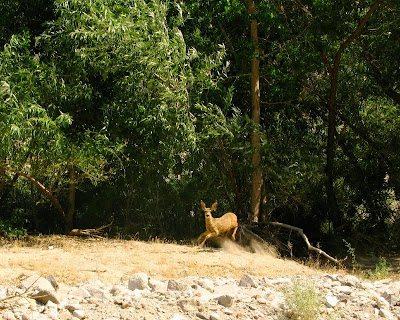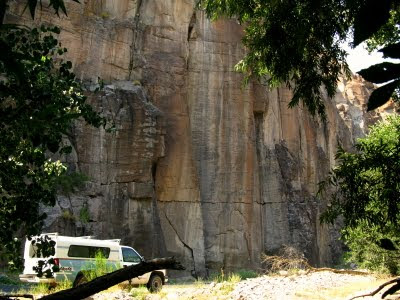 More than a week ago, I left you with this enigma of an outcrop, which occurs at the base of some tall, brownish cliffs at the south end of Rainbow Canyon in Meadow Valley Wash. As seen before, the cliffs show crude columnar jointing. Columnar jointing is often well developed in basalt flows, and similar horizontal joints can occur in basalt dikes.
More than a week ago, I left you with this enigma of an outcrop, which occurs at the base of some tall, brownish cliffs at the south end of Rainbow Canyon in Meadow Valley Wash. As seen before, the cliffs show crude columnar jointing. Columnar jointing is often well developed in basalt flows, and similar horizontal joints can occur in basalt dikes.We are in Nevada, however, where anything goes!
 Taking a closer look at the exposure at the base of one of the cliffs, we see a reddish gray rock with some kind of bedding or flow foliation. My finger is pointing at a lithic fragment.
Taking a closer look at the exposure at the base of one of the cliffs, we see a reddish gray rock with some kind of bedding or flow foliation. My finger is pointing at a lithic fragment. Just beyond the lithic fragment, we see a large, light gray, somewhat flattened pumice fragment. The layering in the rock, which is not really bedding, is from welding of this relatively crystal-rich, rhyolitic ash-flow tuff. The texture is known as eutaxitic, and it is the result of compaction during cooling and welding of the tuff. In this case, the tuff is moderately to strongly welded, not strongly enough to show consistent or strong fiamme as Andrew shows here.
Just beyond the lithic fragment, we see a large, light gray, somewhat flattened pumice fragment. The layering in the rock, which is not really bedding, is from welding of this relatively crystal-rich, rhyolitic ash-flow tuff. The texture is known as eutaxitic, and it is the result of compaction during cooling and welding of the tuff. In this case, the tuff is moderately to strongly welded, not strongly enough to show consistent or strong fiamme as Andrew shows here. Looking straight up from the base of the cliff, we get this view. The rocks generally become lighter toward the top of the cliff and above our view, with welding decreasing gradually in intensity. The lighter color of the upper part of the tuff can be seen best in my first picture of these cliffs, from my first post on our 1978 camp in Meadow Valley Wash. In that month-ago post, when I described the rocks at the base of these cliffs, I answered last week's question!
Looking straight up from the base of the cliff, we get this view. The rocks generally become lighter toward the top of the cliff and above our view, with welding decreasing gradually in intensity. The lighter color of the upper part of the tuff can be seen best in my first picture of these cliffs, from my first post on our 1978 camp in Meadow Valley Wash. In that month-ago post, when I described the rocks at the base of these cliffs, I answered last week's question! Large boulders of the lighter-colored, upper part of this ash-flow tuff have broken off and fallen from the top of the cliffs, and can be accessed easily along Highway 317. The upper part of the tuff - as seen in these roadside boulders - is moderately welded and shows compaction foliation (flattened pumice). The pinkish gray rock in my hand is a piece of this same tuff. Some of the larger boulders that fell from the upper part of the cliffs can be seen in the next photo.
Large boulders of the lighter-colored, upper part of this ash-flow tuff have broken off and fallen from the top of the cliffs, and can be accessed easily along Highway 317. The upper part of the tuff - as seen in these roadside boulders - is moderately welded and shows compaction foliation (flattened pumice). The pinkish gray rock in my hand is a piece of this same tuff. Some of the larger boulders that fell from the upper part of the cliffs can be seen in the next photo. Columnar jointing is fairly common in the more strongly welded portions of some ash-flow tuff formations in Nevada; they are often dark brown, dark reddish brown, or dark orangish brown. These columnar-jointed welded tuffs can be confused with basalt from a distance - and the two rock types can even be confused up close if you haven't broken open a rock or two. After gaining some experience with this phenomenon, you may become confident enough to pronounce some dark volcanic columns capping a distant hill as either ash-flow tuff or basalt - but without having seen geologic maps of the area or walked over to the outcrop, even an experienced person can get it wrong.
Columnar jointing is fairly common in the more strongly welded portions of some ash-flow tuff formations in Nevada; they are often dark brown, dark reddish brown, or dark orangish brown. These columnar-jointed welded tuffs can be confused with basalt from a distance - and the two rock types can even be confused up close if you haven't broken open a rock or two. After gaining some experience with this phenomenon, you may become confident enough to pronounce some dark volcanic columns capping a distant hill as either ash-flow tuff or basalt - but without having seen geologic maps of the area or walked over to the outcrop, even an experienced person can get it wrong. This ash-flow tuff is called Tt4 on this map. Tt4, which lumps several ash-flow tuff formations, is described here as including "poorly to densely welded, crystal poor, bimodal high-silica rhyolite and peralkaline ash-flow tuff and related airfall tuffs; gray, red, tan, and brown." The tuff in our cliffs is probably the 14.0 Ma tuff of Etna or the 12.6(?) to 11.4(?) Ma Ox Valley Tuff - dates are from Rowley et al, 1995.
This ash-flow tuff is called Tt4 on this map. Tt4, which lumps several ash-flow tuff formations, is described here as including "poorly to densely welded, crystal poor, bimodal high-silica rhyolite and peralkaline ash-flow tuff and related airfall tuffs; gray, red, tan, and brown." The tuff in our cliffs is probably the 14.0 Ma tuff of Etna or the 12.6(?) to 11.4(?) Ma Ox Valley Tuff - dates are from Rowley et al, 1995. The Ox Valley Tuff is "a light-gray, crystal-poor, poorly to densely welded, high-silica rhyolite ash-flow tuff whose outflow consists in most places of one to four cooling units that generally total less than 40 m thick but may be as thick as 130 m" (Rowley et al, 1995). Note that this description of "crystal-poor" doesn't match our earlier crystal-rich pronouncement. The description goes on to say that the Ox Valley Tuff contains 30 to 40% phenocrysts, which seems more than crystal-poor to me, but phenocryst percentage in an ash-flow tuff varies with degree of welding, and we are looking at a relatively densely welded part of this unit. The most abundant phenocrysts in the Ox Valley Tuff are sanidine and quartz. Plagioclase, amphibole, and clinopyroxene were noted in decreasing abundance, with trace to minor biotite.
The Ox Valley Tuff is "a light-gray, crystal-poor, poorly to densely welded, high-silica rhyolite ash-flow tuff whose outflow consists in most places of one to four cooling units that generally total less than 40 m thick but may be as thick as 130 m" (Rowley et al, 1995). Note that this description of "crystal-poor" doesn't match our earlier crystal-rich pronouncement. The description goes on to say that the Ox Valley Tuff contains 30 to 40% phenocrysts, which seems more than crystal-poor to me, but phenocryst percentage in an ash-flow tuff varies with degree of welding, and we are looking at a relatively densely welded part of this unit. The most abundant phenocrysts in the Ox Valley Tuff are sanidine and quartz. Plagioclase, amphibole, and clinopyroxene were noted in decreasing abundance, with trace to minor biotite. About 75 m of tuff is exposed at our location, from the base of the cliffs to the base of the overlying basalt flows. With the base of the tuff not exposed - or with it exposed in the canyon somewhere to the north - the tuff may be as thick as 100 m or more in this general area.
About 75 m of tuff is exposed at our location, from the base of the cliffs to the base of the overlying basalt flows. With the base of the tuff not exposed - or with it exposed in the canyon somewhere to the north - the tuff may be as thick as 100 m or more in this general area. After dinking around at the base of these spectacular cliffs, I turned my sights on the trees lining Meadow Valley Wash and scared up a deer.
After dinking around at the base of these spectacular cliffs, I turned my sights on the trees lining Meadow Valley Wash and scared up a deer. I walked over to the running creek and got my feet wet once again.
I walked over to the running creek and got my feet wet once again. After cooling off in the shade, I turned back toward the cliffs, which stand like sentinels over the partly washed out road.
After cooling off in the shade, I turned back toward the cliffs, which stand like sentinels over the partly washed out road. I then headed back to my truck to continue my drive north in Rainbow Canyon, north toward Caliente.
I then headed back to my truck to continue my drive north in Rainbow Canyon, north toward Caliente.Some References:
Page, W.R., Dixon, G.L., Rowley, P.D., and Brickey, D.W., 2005, Geologic map of parts of the Colorado, White River, and Death Valley groundwater flow systems, Nevada, Utah, and Arizona: NBMG Map 150, map and text.
Rowley, P.D., Nealey, L.D., Unruh, D.M., Snee, L.W., Mehnert, H.H., Anderson, R.E., and Gromme, C.S., 1995, Stratigraphy of Miocene ash-flow tuffs in and near the Caliente caldera complex, southeastern Nevada and southwestern Utah: in Scott, R.B. and Swadley, WC, eds., Geologic Studies in the Basin and Range - Colorado Plateau transition in southeastern Nevada, southwestern Utah, and northwestern Arizona, 1992, U.S. Geological Survey Bulletin, 2056-B, p. 43-88.
2 comments:
I learned a new word today: "fiamme"--thanks! No volcanic rocks around these parts, so I guess it's not too surprising.
I'm glad whoever coined that term used the Italian version, because calling it "flame structure" would create all sorts of havoc for the sedimentologist-types who are familiar with the soft-sediment flame structures.
Cheers,
--Howard (Calgary, AB)
I'll have to dig out some good fiamme pictures!
Post a Comment